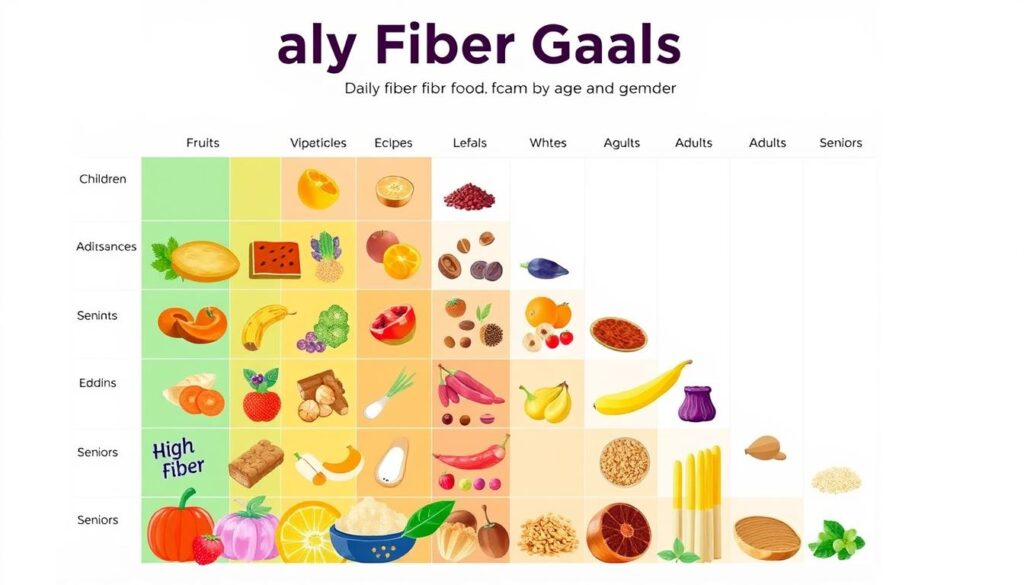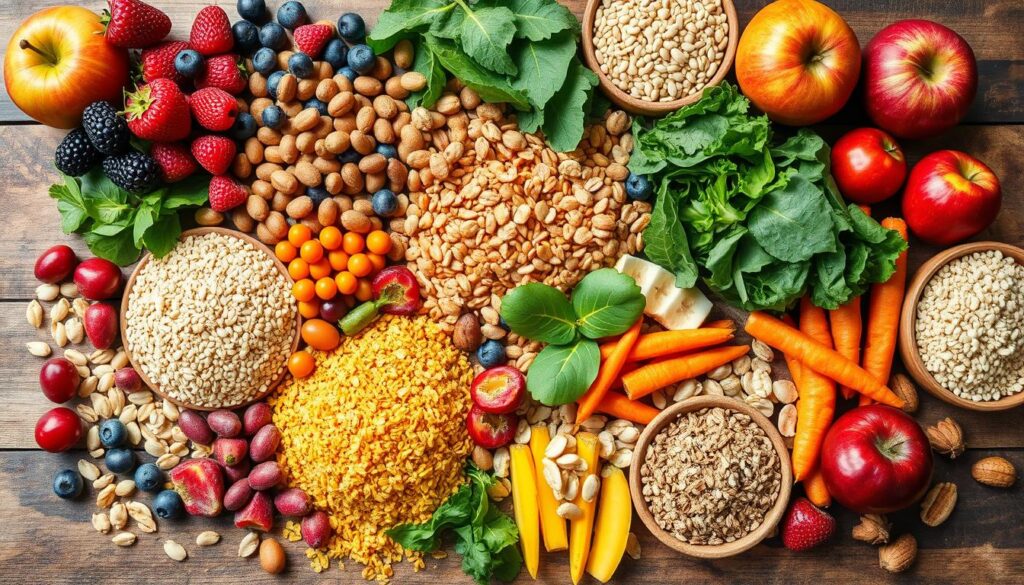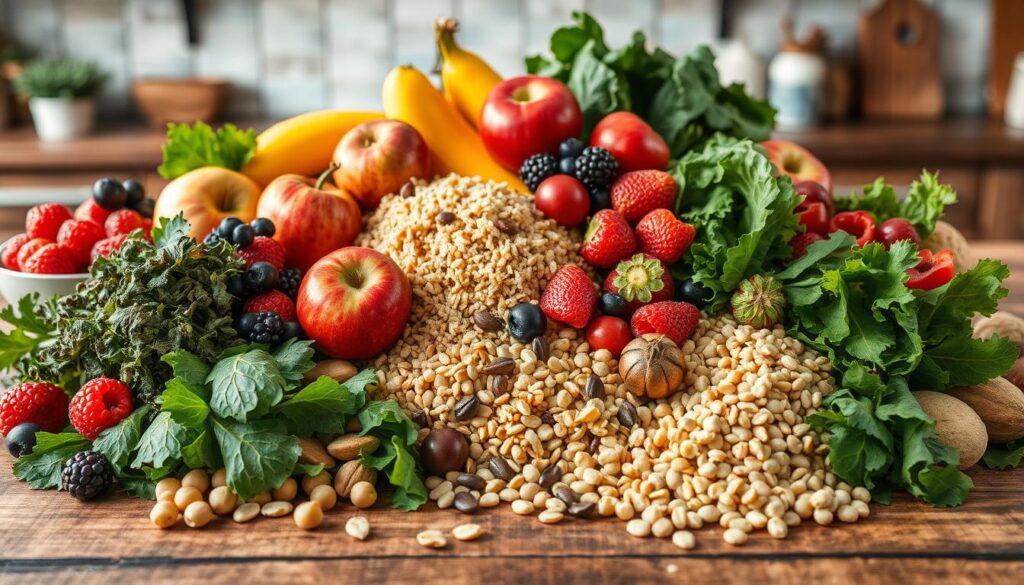Many people struggle with constipation every day. We’ve made a detailed guide to help. It lists high fiber foods that can ease your constipation and improve your digestion. You’ll find fruits, veggies, grains, legumes, nuts, and seeds here.
This guide is perfect if you want to eat more fiber or fight constipation. It shows you the best high fiber foods and how much fiber they have. By choosing foods from this chart, you can eat more fiber and feel better.
Key Takeaways
- This guide provides a detailed overview of high fiber foods to combat constipation.
- It covers a wide range of fruits, vegetables, grains, legumes, nuts, and seeds with their fiber content.
- Incorporating these fiber-rich foods can support improved digestion, larger stool volume, and healthier gut bacteria.
- Using this chart, you can make informed choices to boost your daily fiber intake for better digestive health.
- Gradually increasing fiber-rich foods, while staying hydrated, can help avoid potential side effects like gas or bloating.
Understanding Constipation and Its Impact on Well-being
Constipation is a common problem that affects many people, especially kids and the elderly. It’s estimated that 15-30% of people deal with it. This issue can affect their health and happiness a lot.
It’s important to know why it happens, how it affects us, and why we need more fiber. This helps us stay healthy and feel good.
Common Causes of Constipation
Many things can cause constipation. Medicines, not moving much, not drinking enough water, and eating too little fiber are some reasons. Medicines like antidepressants and iron can mess with our digestion.
Not being active and not drinking enough water also play a part. Eating foods low in fiber is another big reason.
Physical and Mental Health Effects
Constipation can really hurt our body and mind. It can cause painful problems like hemorrhoids and anal fissures. It can also make us feel anxious and sad.
The pain and trouble it causes can make us feel down. It can mess up our daily life a lot.
Signs You Need More Fiber
Knowing when we need more fiber is key. If you go to the bathroom less than three times a week, you might need more fiber. Hard, lumpy stools are another sign.
If you see these signs, it’s time to think about eating more fiber. This can help make you feel better.
“Only an estimated 5% of the U.S. population meets their minimum daily fiber intake. Surveys show that most people, particularly in Western countries, only eat around half of their minimum recommended fiber, which is approximately 15 grams per day.”
The Science Behind Fiber and Digestive Health
Dietary fiber is found in plant foods and helps your digestive system. It makes your stool bigger and easier to pass. It also helps your body move food through your system faster.
This means you have regular bowel movements. It helps keep your digestive system healthy.
Fiber also helps good bacteria in your gut grow. This is important for digestion, absorbing nutrients, and keeping your immune system strong.
| Fiber Type | Description | Health Benefits |
|---|---|---|
| Soluble Fiber | Derived from the inner flesh of plants, including pectin, gums, and mucilage. | May help lower cholesterol levels and stabilize blood sugar. |
| Insoluble Fiber | Comes from the outer skin of plants, such as cellulose, hemicellulose, and lignin. | Promotes regular bowel movements and may reduce the risk of certain cancers. |
Eating foods high in dietary fiber is key. Include fruits, veggies, whole grains, and legumes. This keeps your digestive system and gut health in check. Knowing how fiber works in your body helps you make better choices for your health.
“Fiber is the foundation for a healthy digestive system and a balanced gut microbiome. Prioritizing fiber-rich foods is a simple yet powerful way to support your overall health.”
High Fiber Foods Chart for Constipation
Eating foods high in fiber helps with constipation and keeps your digestive system healthy. You can find fiber in fruits, vegetables, and whole grains. Let’s look at some of the best foods to help your digestive system.
Fruits and Their Fiber Content
Fruits like raspberries, pears, and apples are full of fiber. Raspberries have 8 grams of fiber per cup. A medium pear has 5.5 grams, and an apple has 4.5 grams.
Other fruits like prunes, dried figs, and blackberries are also good. Prunes have 6 grams of fiber per 10 prunes. Dried figs have 9 grams per 10 figs. Blackberries have 7 grams of fiber per 3/4 cup.
Vegetables Rich in Fiber
Vegetables are great for adding fiber to your diet. Green peas have 9 grams of fiber per cup. Broccoli and Brussels sprouts have 5 grams and 4.5 grams per cup, respectively.
Baked beans are a big fiber source with 14 grams per cup. Pinto beans have 14.7 grams per cup. Other veggies like turnip greens, parsnips, zucchini, and carrots also have fiber. They have about 3 grams of fiber per 1/2 cup.
Legumes and Whole Grains
Legumes and whole grains are very fiber-rich. Split peas and lentils have 16 grams and 15.5 grams of fiber per cup. Whole grains like barley and quinoa have 6 grams and 5 grams of fiber per cup.
Cereals like Fiber One and All-Bran are also good for fiber. They have 13 grams and 10 grams of fiber per 1/2 cup, respectively.
Adding these foods to your diet helps fight constipation and keeps your digestive system healthy.
Daily Fiber Requirements by Age and Gender
Getting enough fiber is key for good health. The recommended fiber intake is 14 grams for every 1,000 calories for people over 2. Kids aged 12-23 months need 19 grams a day.
But, most Americans only get 12-18 grams of fiber each day. Your fiber needs change with age, gender, and how many calories you eat.
- Women under 50: 25 to 28 grams per day
- Men under 50: 31 to 34 grams per day
- Women 51 and older: 22 grams per day
- Men 51 and older: 28 grams per day
- Children and teens (ages 1-18): 14 to 31 grams per day
Knowing your daily fiber goals helps you make better food choices. This way, you meet your recommended fiber intake and follow digestive guidelines.

“Only 5 percent of Americans meet their daily fiber requirements, with most falling short.”
Eating more fiber can help your digestion and lower disease risks. Start adding more fiber slowly to avoid side effects. Find the right amount for you.
Types of Dietary Fiber: Soluble vs. Insoluble
Dietary fiber comes in two main types: soluble and insoluble. Each type has its own role in keeping your digestive system healthy. Knowing the benefits of each can help you choose the right foods for your diet.
Benefits of Soluble Fiber
Soluble fiber is found in foods like oats, bananas, and oranges. It absorbs water and turns into a gel in your stomach. This helps with diarrhea and keeps your stool solid.
It also helps lower cholesterol levels. This can reduce the risk of heart disease.
Benefits of Insoluble Fiber
Insoluble fiber works like a brush in your bowels. It helps move waste and keeps your bowel movements regular. Foods like bran and beans are good sources of insoluble fiber.
Both soluble fiber and insoluble fiber are key for a healthy diet. Eating foods high in fiber can improve your health and well-being.
“More than 90% of women do not meet the recommended dietary fiber intake.”
Finding the right balance of both types of fiber is important. It helps keep your digestive system healthy. With the right foods, you can make the most of fiber’s benefits.
Strategic Meal Planning for Optimal Fiber Intake
Making a meal plan rich in fiber is key for a balanced diet. It helps with constipation too. By adding many high-fiber foods, your body gets what it needs.
Begin with oatmeal and berries for breakfast. Lunch can be turkey chili with kidney beans. Dinner might be grilled chicken with broccoli and carrots.
Don’t jump too fast into more fiber. Start slow to avoid stomach issues. Drink lots of water with your meals. It helps fiber work better.
| Meal | Fiber-Rich Ingredients | Fiber Content (grams) |
|---|---|---|
| Breakfast | Oatmeal with strawberries | 8 |
| Lunch | Turkey chili with beans | 12 |
| Dinner | Grilled chicken with roasted vegetables | 10 |
| Total Daily Fiber | – | 30 |
Plan your meals with fiber in mind. This keeps your digestive system healthy. A fiber-rich meal plan is good for you. A balanced diet with constipation relief diet options is best for your health.

Incorporating Fiber-Rich Foods Into Your Diet
Adding more fiber to your diet can be fun. Try high-fiber breakfasts, meals, and snacks. This way, you get a diet full of fiber.
Breakfast Options
Begin with a fiber-rich breakfast. Choose whole grain cereals like oats, which have 5 grams of fiber per cup. Make a smoothie with raspberries (8 grams of fiber per cup) and avocado (6.7 grams of fiber per 100 grams).
For something different, try avocado toast on whole-grain bread. It has 3.5 grams of fiber per slice.
Lunch and Dinner Ideas
For lunch and dinner, add legumes like lentils. They have 12.2 grams of fiber per cup when cooked. Mix them into salads, soups, or stews.
Try whole grain pasta, like quinoa or whole wheat pasta. They have 5-7 grams of fiber per cooked cup. Add lots of fiber-rich veggies like broccoli (5 grams of fiber per cup) and artichoke hearts (14 grams of fiber per cup).
Healthy Snack Suggestions
Choose fiber-filled snacks to keep you full. Nuts like almonds have 6 grams of fiber per 23 nuts. Fresh fruits like pears (6 grams of fiber per medium pear) and apples (4.4 grams of fiber per medium apple) are great snacks.
For a crunchy snack, try air-popped popcorn. It has 1.15 grams of fiber per cup.
By swapping to high-fiber foods, you can easily increase your fiber intake. This supports your health and well-being.
Hydration and Fiber: The Perfect Partnership
For good digestive health, you need water and fiber together. Fiber helps keep things moving and makes your gut happy. But, it needs water to work right.
Water helps fiber do its job. When you eat more fiber, drink more water too. Try to drink 8 to 10 cups of water each day. This helps fiber move well in your body and prevents constipation.
When you add more fiber, also drink more water. This way, fiber can do its job well. It helps you go to the bathroom regularly and keeps your digestive health good. If you don’t drink enough water, you might feel bloated or uncomfortable.
“Fiber and water work hand-in-hand to support a healthy, happy gut. Staying hydrated is crucial for ensuring the water intake and fiber effectiveness work in perfect harmony.”
Start slow with a high-fiber diet. Increase both fiber and water slowly. Listen to how your body feels. With time and patience, you’ll get better digestive health and regular bowel movements.
Potential Side Effects and How to Avoid Them
Adding more fiber to your diet can be good for your stomach. But, you should do it slowly to avoid feeling bad. Eating too much fiber too fast can cause gas, bloating, and stomach pain.
To avoid these problems, start small. Add a little bit of fiber-rich foods like fruits, veggies, whole grains, and legumes to your meals. Then, slowly eat more as your body gets used to it.
If you start to feel bad, like too much gas or pain, cut back a bit. Then, slowly add more fiber again. Always talk to a doctor before big diet changes. They can help based on what you need.
Drinking lots of water is also important when you eat more fiber. It helps your body digest the fiber better and prevents constipation.
A 2012 study found that people with constipation, bloating, and stomach pain felt better after eating less fiber. They had more bowel movements, less bloating, and less pain.
By slowly adding more fiber and drinking water, you can enjoy its benefits without feeling bad. Being patient and consistent is important for adding fiber to your diet.
| Fiber Type | Benefits |
|---|---|
| Soluble Fiber | Helps keep stools soft and slows down the digestive process. |
| Insoluble Fiber | Adds bulk to bowel movements and aids in the movement of food through the digestive system. |
The right amount of fiber depends on your gender, age, and if you’re pregnant. Talk to a doctor to find out how much fiber you should eat. They can help you smoothly increase your fiber intake.
Beyond Digestive Health: Additional Benefits of High-Fiber Diet
Fiber is good for your gut. But it does more than that. Eating foods high in fiber can make you feel better in many ways.
Weight Management Benefits
Foods like fruits, veggies, and whole grains are full of fiber. They make you feel full and eat less. This can help you lose weight slowly and keep it off.
Heart Health Advantages
Fiber is great for your heart. It helps lower bad cholesterol. This can lower your risk of heart disease.
Blood Sugar Control
Fiber, especially soluble fiber, helps control blood sugar. It slows down sugar absorption. This is good for people with diabetes or at risk of it.


A Life-Changing Experience with This Weight Loss Supplement (Nagano Tonic)
I’ve always struggled with finding a weight loss solution that actually works for me. Like many, I’ve tried numerous diets, exercise routines, and supplements over the years—some worked for a short time, but nothing ever gave me long-term results. That was until I decided to try the weight loss supplement I found : Link to the Supplement.
From the moment I started using it, I noticed a difference. Not only did I feel more energized, but my cravings also became more manageable. The best part? I started seeing results much quicker than I anticipated! Over the course of just a few weeks, I noticed a significant reduction in belly fat and overall weight loss that I hadn’t been able to achieve before.
What makes this supplement stand out from all the others I’ve tried is how it supports me in my daily routine without any jitters or energy crashes. I’m able to stay focused and motivated, which has made it easier to stay on track with my diet and exercise plan.
This product truly exceeded my expectations, and I feel more confident and healthier than ever before. If you’re struggling with your weight loss journey like I was, I highly recommend giving this supplement a try. It’s been a game-changer for me, and I’m sure it can work wonders for you too!
Contant Them on email .. tonicnagano50@gmail.com
I’ve tried so many weight loss products over the years, but nothing worked like this supplement! Since I started using it, I’ve noticed a big difference in my energy levels and appetite control. In just a few weeks, I’ve lost weight and feel so much better. It’s been easy to stick with, and the results speak for themselves. Highly recommend this to anyone looking to make a real change!
wasn’t sure what to expect, but this weight loss supplement has really impressed me! After just a few weeks of use, I’ve already dropped a few pounds and feel more motivated to stay active. It’s helped curb my cravings and boosted my energy throughout the day. I’m excited to keep going and see even better results. Definitely worth trying!
Reach them on tonicnagano50@gmail.com
I was skeptical at first, but this supplement has truly made a difference in my weight loss journey. I’ve lost weight without feeling deprived or sluggish. My cravings are under control, and I feel more confident in my body. It’s easy to incorporate into my daily routine, and the results speak for themselves. I’m so glad I gave it a try!
Thanks David, i do use the link to make my purchase. you can get too here http://surl.li/iasppy
I’ve tried so many weight loss products, but this one has been by far the most effective. In just a few weeks, I’ve noticed a visible difference in my body and energy levels. It’s helped me stay on track without the constant hunger pangs and cravings. I’m really happy with my progress and can’t wait to see where I’ll be in another month!
This Nagano Tonic has been amazing! In just a few weeks, I’ve lost weight, feel more energized, and my cravings are under control. Highly recommend it!
Thats the link to purchase http://surl.li/iasppy